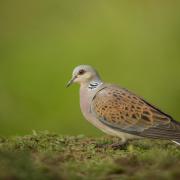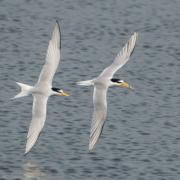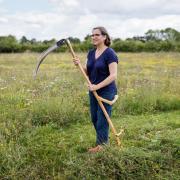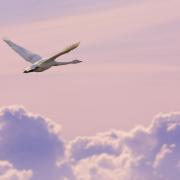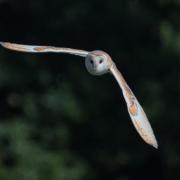The great crested grebe’s courtship dance is a fascinating and rarely captured moment that is happening in Suffolk’s lakes

From February and throughout the spring one of nature’s most beautiful sights can be seen on many of Suffolk’s lakes. The courtship display, or dance, of the great crested grebe is an amazing spectacle to watch as the birds go through an elaborate set of moves worthy of any Strictly Come Dancing routine.
It all starts with a pair of grebes that have established a territory on a lake calling towards each other across the water. This is to confirm their partnership and is what happens for most of the time when you watch them. As they swim around their territory they will often head towards each other and then reaffirm their relationship with a series of ‘dance moves’, as both birds face each other and perform a set of head bobs and shakes, whilst calling to each other and showing off their crest feathers on top of their heads. This dance can go on for several minutes at a time before the grebes head off in their own directions.
This behaviour itself is a pleasure to watch, but the real show stopper is the weed dance. This is when after a series of calls both birds dive down into the water and resurface carrying weed in their beaks. They then rush across the surface of the water towards each other. When they meet they rear up out of the water, paddling frantically to stay afloat whist performing their display. The weed dance only lasts a few seconds and is something I have only seen, let alone photographed, a few times.
The main image here of the grebes performing their weed dance was photographed on the lake at West Stow Country Park near to Bury St Edmunds. I have spent many hours there watching and photographing the wildlife on and around the lake.
On this particular early spring morning I arrived for sunrise to find the pair of grebes were happily courting on the lake. For most of the morning the pair would only call to each other or were only performing their head bobbing dance. Like with most wildlife action you do not get much warning but when I saw both birds resurface from their dives and started to rush towards each other I knew the opportunity for a weed dance was on. I only had a second or two to focus on the birds, but everything came together and I was able to get a series of images that I was pleased with.
Over a five-hour period this was the only time these grebes performed the weed dance, furthering my belief that patience and perseverance are two big keys for wildlife photography.
February wildlife highlights
As I write this to make the editorial deadline it is the weekend before Christmas and I had planned to highlight the first spring flowers that could be coming in to bloom in February. However, with snowdrops and daffodils presently in flower, plus blossom on some ornamental trees, it is hard to predict where the climate will be in February 2016.
Traditionally we should start to see the first spring flowers coming into bloom in February. These include species such as lesser celandine, which spread their beautiful yellow carpet of flowers across our woodlands. Dog violets and primroses would also be starting to flower in the woodlands. Some of our trees such hazel and some willows will have produced their catkins. On warm days you may even see the occasional butterfly as several species like the Small Tortoiseshell, Peacock And Red Admiral all hibernate for the winter and are woken by the mild weather. Frogs, and maybe toads, should be spawning in local lakes and ponds, and should we get a few warm days reptiles will start to come out of hibernation.
It will be very interesting to see what the weather is like when you read this, but our region’s wildlife will have to adapt to the changing climate.


















